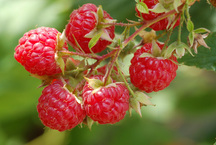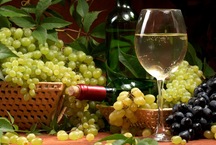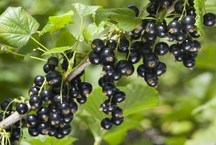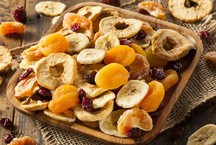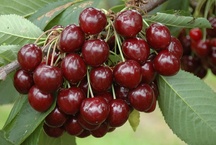8 best sweet cherry varieties





Sweet cherry is a sweet and fragrant southerner with early ripening. It is highly tempting to plant a slender tree on its plot and feast on the fruits with delicate pulp. According to the experience of gardeners of the Moscow region, Middle zone and the Southern Urals, growing sweet cherry trees and obtaining a rich harvest is akin to art. The main problems that arise when planting a heat-loving tree in a harsh climate are associated with insufficient winter hardiness and susceptibility to diseases. It is these characteristics that need to be paid attention to when choosing the best variety of sweet cherries for the Moscow region.
The cherry is samobesplodna, so for setting fruit you need a pollinator with the same flowering period. Planting a tree can not do. But alternatively, another variety can be grafted into the crown of an adult tree. Cherries are vigorous trees, and for normal development they are planted at a distance of 4–5 m. They form a powerful, deeply penetrating root system and do not tolerate close passage of groundwater. These features must be considered when evaluating your plot, so that planted trees will not have to be rooted out after a few years.
For the best varieties of sweet cherries for the Moscow region and the Central zone, the Urals, the southern regions, read more in our rating, compiled from expert and experienced gardeners.
The best grades of sweet cherry - Top 8
| Category | A place | Name | Rating | Price |
|---|---|---|---|---|
| The best early varieties of sweet cherry | 1 | Iput | 9.8 / 10 | 500 |
| 2 | Chermashnaya | 9.7 / 10 | 850 | |
| 3 | Ovstuzenka | 9.7 / 10 | 420 | |
| The best mid-season varieties of sweet cherry | 1 | Fatezh | 9.8 / 10 | 850 |
| 2 | Gift to Stepanov | 9.7 / 10 | 420 | |
| The best late varieties of sweet cherries | 1 | Bryansk Pink | 9.8 / 10 | 850 |
| 2 | Revna | 9.8 / 10 | 730 | |
| 3 | Tyutchevka | 9.7 / 10 | 420 |
The best early varieties of sweet cherry
|
Iput
500 (one-year-old in a container (ZKS))
The early variety, which ripens in mid-June, opens our ranking of the best varieties of cherries. Tree height of 4 - 6 m. Crohn wide-pyramidal, dense. Fruits leveled, weigh from 5 to 10 g, obtuse, black-and-red, with dark-red tender pulp of average density, bone seperability is average. To taste juicy-sweet with sourness. The ripened fruits have an appetizing, attractive, presentation. With a lack of heat and sun, the fruits get a tart flavor and pronounced acidity. In favorable years, 25 - 35 kg are collected from one tree. Winter hardiness in this variety of cherries is good, but in severe winters there is a slight frosting growth and moderate damage to flower buds. After returning spring frosts, no more than 60% of the ovaries are damaged. Resistant to diseases. Recommended in the Central and Central Black Earth regions. In the Moscow region, Nizhny Novgorod, Penza and Samara, gardeners have noted good adaptation qualities. Pollinating varieties: Revna, Tyutchevka, Bryansk Pink, Ovstuzhenka and Raditsa.
Main advantages:
Minuses:
|
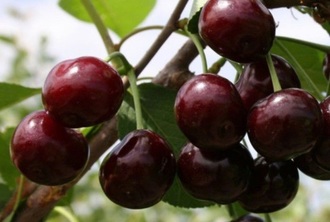 9.8 / 10
Rating
Reviews
Good, very early variety of sweet cherries, not sick. I have ripened with garden strawberries. The fruits are large, but watery and sour. |
|
Chermashnaya
850 (two-year-old in a container (ZKS))
Yellow cherries with early ripening. Tree height 4.5 - 5 m. Crohn spherical, raised, not thickened. Fruits are one-dimensional, even, rounded, weighing 4 - 4.5 g on average, pale yellow, with a thin and dense skin. Taste is sweet, sweet and slightly sour. The flesh is juicy and tender, yellow, bone separation is good. There is unfriendly ripening. The average yield of an adult tree is 15-20 kg. The variety is absolutely self-fruitless, i.e., without a pollinator, it will not tie any fruit.For pereopyleniya plant Fatezh, Raditsa or Bryansk pink. Differs in precocity: fruiting begins at 3 - 4 years after planting. Winter hardiness of wood at the level of average indicators, flower buds can be damaged by spring frosts. Recommended for cultivation in the Black Earth region. There is a positive experience of cultivation in the suburbs, but gardeners after the harsh winters mark the appearance of frost cracks on the bark. Main advantages:
Minuses:
|
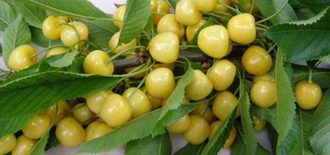 9.7 / 10
Rating
Reviews
A good yellow sweet cherry, a tree just covered with berries. I like the fact that when ripening the neighbor's red-fruit cherries, our Chermashnaya does not attract starlings. |
|
Ovstuzenka
420 (one year with an open root system)
A good variety of sweet cherries with early ripening. Trees 3–4 m high, with a dense, raised, spherical crown. The short stature of the trees facilitates harvesting and allows you to protect the fruit from starlings. Fruits are round, saturated-maroon, weigh 4 - 7 g, the flesh is dark red. They are easily separated from the stem, with a dry separation, the separation of the bone from the flesh is good, it does not crack. The taste is juicy and sweet, without astringency. The yield of one tree with good care and without damage is 50 - 60 kg, in the first years of fruiting - 10 - 15 kg. Partially self-fertile, therefore, even without a pollinator, it sets up a small (about 5%) number of fruits. Pollinating varieties: Revna, Bryansk Pink, Iput, Tyutchevka, Raditsa. Differs in high winter hardiness and frost resistance, including flower buds and ovaries. It shows high resistance to coccomycosis and moniliasis, moderately affected by cholesterol. The variety is zoned in the Central region. There is a good growing experience in Chelyabinsk and in the Middle Belt. Main advantages:
Minuses:
|
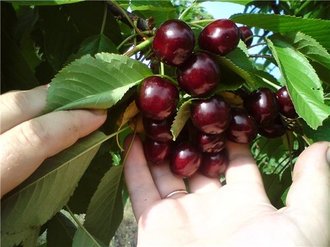 9.7 / 10
Rating
Reviews
In general, satisfied with the variety. Good classic sweet cherry in appearance and taste of the fruit. It does not cause problems and is always covered with berries. |
The best mid-season varieties of sweet cherry
|
Fatezh
850 (two-year-old in a container (ZKS))
Fruits ripen in average terms, from the second decade of July. The tree grows up to 4 - 5 m. The crown is spreading, spherical, of average density, it needs to be shaped to maintain a compact form. Under the weight of the harvest, the lower branches wilted. Fruits leveled, well-rounded, weigh 3.8 - 6 g, yellow with a large red blush, with a dry separation from the stem. To taste juicy-sweet with a pleasant sourness. The flesh is pink, dense. The stone is easily separated from the pulp. Up to 50 kg are collected from one adult tree; in the first years of fruiting, productivity at the level of 10-30 kg. This variety of sweet cherry is recommended for cultivation in the Central region, Moscow region. A positive growing experience has been obtained in many areas of the Central Belt. As pollinators plant Chermashna, Revne, Ovshuzhenka, Raditsu or Iput.
Main advantages:
Minuses:
|
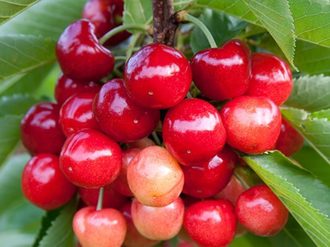 9.8 / 10
Rating
Reviews
The fruits are too small, but the harvest is sweet cherry, and even unripe fruits are quite sweet. |
|
Gift to Stepanov
420 (one year with an open root system)
New medium-late variety of sweet cherry from the Bryansk selection. Tree height of 4 - 5 m, with a pyramidal, sparse crown. Fruits are saturated red or burgundy, weighing 3.5 - 4.5 g, leveled, blunt-centered, with dark red, juicy, cartilaginous pulp and delicate skin. Sweet taste, estimated at 4.9 - 5 points.The peduncle comes off easily, the bone separates well. In the description of this variety of cherries, good resistance to major diseases and high winter-resistance are stated. In the State Register since 2015, zoned in the Central region. Gardeners also grow this variety of sweet cherries in Nizhny Novgorod and Chelyabinsk. Main advantages:
Minuses:
|
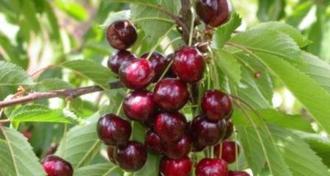 9.7 / 10
Rating
Reviews
The one-year sapling of a sweet cherry quickly got accustomed and began to grow, adapts well to the growing conditions. |
The best late varieties of sweet cherries
|
Bryansk Pink
850 (two-year-old in a container (ZKS))
Universal variety of sweet cherry with late ripening. Tree height of 4 - 4.5 m, characterized by slow growth. The crown is wide-pyramidal, raised, moderately thickened. Pink fruits with tan and characteristic speckles, on average, weigh 4-5.5 g, regular round shape, with a dry margin, do not crack when overwetted. The pulp is dense, yellow, with weak cartilaginousness. Juice light. Separation of the bone from the pulp is average. The taste is juicy-sweet, with a slightly pronounced bitterness. One tree produces an average of 20–30 kg of fruit. Ovstuzhenka, Tyutchevka, Iput and Revna are suitable as pollinators. The stability of the trunk and skeletal branches to frost is observed. High winter hardiness of wood and flower buds, sensitivity to spring frosts. High resistance to coccomycosis, moniliozu and klyasteporiozu. Recommended for cultivation in the Central region, is widely distributed throughout the Central Belt.
Main advantages:
Minuses:
|
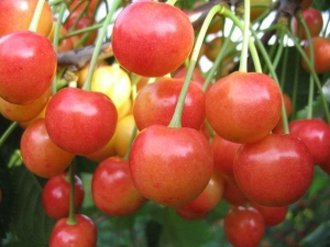 9.8 / 10
Rating
Reviews
Good sweet cherry for the Moscow region, the fruits are small, but sugary-sweet. The variety is not sickly and not capricious, but the harvest gives a stable. |
|
Revna
730 (two years in agronomic grid)
Good proven variety of late ripe cherries. The tree is fast-growing, 4–5 m high, with a pyramidal sparse crown. It lends itself well to all types of shaping. The fruits are beautiful, broadly rounded, weighing from 5 to 8 g, dark red, almost blackening when ripe, with a dry margin, transportable. The flesh is rich red, dense. Stone separates well. The taste is juicy and sweet, while tasting it scores 4.8 - 5 points. The average productivity of a single tree is 30 kg. The variety is partially self-fertile: without a pollinator, it sets up to 5% of the potential number of fruits. Good pollinators are Ovstuzhenka, Tyutchevka, Raditsa, Iput. Stambs and skeletal branches are not affected by freezers. It shows high winter hardiness and good resistance to return frosts. Differs in good immunity. Zoned in the Central region, but is actively grown throughout the Central Belt.
Main advantages:
Minuses:
|
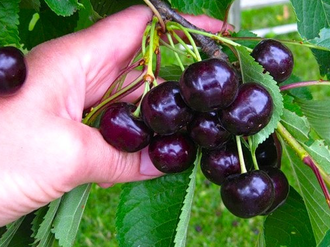 9.8 / 10
Rating
Reviews
A young tree is always healthy and strong, even after a harsh winter looks better than other sweet cherry. |
|
Tyutchevka
420 (one year with an open root system)
Cherry late, ripens in late July. The tree is medium thick, 4–6 m high. The crown is spherical, sparse, moderately sprawling. Fruits weigh from 5 to 7.4 g, rounded with a wide base, red with speck. The pulp is dense, red. Bone separation from the pulp is average. Fruits are transportable, with a dry margin. Tastes excellent. Up to 40 kg can be collected from one tree each year. The variety is partially self-propelled. For pollination they plant Iput, Raditsa, Revny or Ovshuzhenka. Under the conditions of the Moscow region, gardeners note the cracking of berries when rainy weather is established during the ripening period.Moderately affected is kleasterospiosis and coccomycosis, very rarely - moniliosis. In severe winters, trees freeze slightly. Spring frosts during flowering can kill up to 70% of the ovaries. Zoned for the Central region, successfully grown in the Middle Belt and the South Urals.
Main advantages:
Minuses:
|
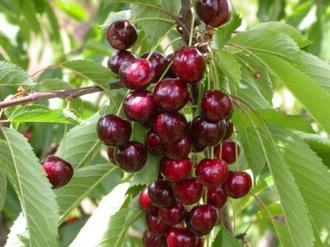 9.7 / 10
Rating
Reviews
The best sweet cherry for the Moscow region, in my opinion. Surprises high frost resistance. I appreciate the fruits by 5 points, even the unripe sweets, and children eat with pleasure. |
In a review, the forum users also recommend the varieties of sweet cherry: Rossoshanskaya Rosy, Bryanochka, Teremoshka, Milan, In memory of Astakhov, Radits and Valery Chkalov. Choosing a cherry for their plot, gardeners of the Middle zone more often prefer medium and winter hardy varieties.
For the sweet cherry, as for the thermophilic culture, spring planting is desirable. Acquire seedlings with unblown buds. If the leaves are opened in the warmth, then the seedling should be urgently planted in the ground to prevent desiccation of shoots and roots. In regions with a lingering spring, it is better to buy planting material with a closed root system: in a container, a tree will safely endure waiting for planting. The landing pit is prepared in the fall, and the soil mix for backfilling is stored in a closed unheated room. These measures will allow to land in the earliest terms.
With cherries there are very frequent cases of re-grading, when the southern varieties give out for zoned. Sweet cherry seedlings are better to buy in proven stores, in local nurseries or from private gardeners with a good reputation.
Have a good harvest!
